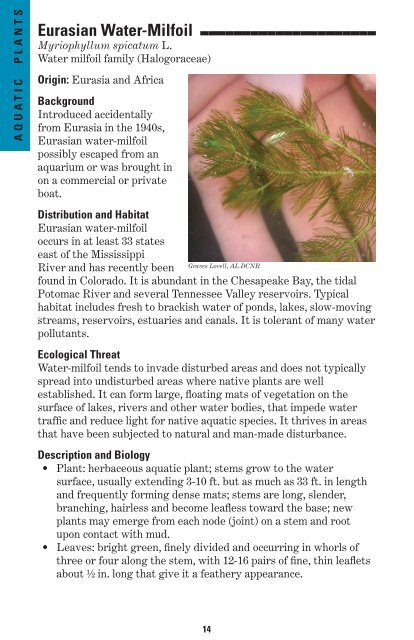Plant Invaders of Mid-Atlantic Natural Areas - National Park Service
Plant Invaders of Mid-Atlantic Natural Areas - National Park Service
Plant Invaders of Mid-Atlantic Natural Areas - National Park Service
Create successful ePaper yourself
Turn your PDF publications into a flip-book with our unique Google optimized e-Paper software.
AQUATIC PLANTS<br />
Eurasian Water-Milfoil _____________________<br />
Myriophyllum spicatum L.<br />
Water milfoil family (Halogoraceae)<br />
Origin: Eurasia and Africa<br />
Background<br />
Introduced accidentally<br />
from Eurasia in the 1940s,<br />
Eurasian water-milfoil<br />
possibly escaped from an<br />
aquarium or was brought in<br />
on a commercial or private<br />
boat.<br />
Distribution and Habitat<br />
Eurasian water-milfoil<br />
occurs in at least 33 states<br />
east <strong>of</strong> the Mississippi<br />
River and has recently been Graves Lovell, AL DCNR<br />
found in Colorado. It is abundant in the Chesapeake Bay, the tidal<br />
Potomac River and several Tennessee Valley reservoirs. Typical<br />
habitat includes fresh to brackish water <strong>of</strong> ponds, lakes, slow-moving<br />
streams, reservoirs, estuaries and canals. It is tolerant <strong>of</strong> many water<br />
pollutants.<br />
Ecological Threat<br />
Water-milfoil tends to invade disturbed areas and does not typically<br />
spread into undisturbed areas where native plants are well<br />
established. It can form large, floating mats <strong>of</strong> vegetation on the<br />
surface <strong>of</strong> lakes, rivers and other water bodies, that impede water<br />
traffic and reduce light for native aquatic species. It thrives in areas<br />
that have been subjected to natural and man-made disturbance.<br />
Description and Biology<br />
• <strong>Plant</strong>: herbaceous aquatic plant; stems grow to the water<br />
surface, usually extending 3-10 ft. but as much as 33 ft. in length<br />
and frequently forming dense mats; stems are long, slender,<br />
branching, hairless and become leafless toward the base; new<br />
plants may emerge from each node (joint) on a stem and root<br />
upon contact with mud.<br />
• Leaves: bright green, finely divided and occurring in whorls <strong>of</strong><br />
three or four along the stem, with 12-16 pairs <strong>of</strong> fine, thin leaflets<br />
about ½ in. long that give it a feathery appearance.<br />
14

















